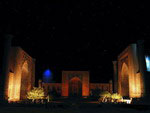 |
| source: e-samarkand.narod.ru |
Registan - is the heart of Samarkand. Located in the heart of the city, an area surrounded by the architectural ensemble of three madrasahs, for centuries has been a meeting point for residents. It echoed the orders of rulers spread news and rumors.
The word "Registan" in Persian means - the place covered with sand. By the way, there is also so called the central area in some other Central Asian cities, and is also so called desert in Afghanistan.
Once from this area Tamerlane's troops went to war. But after awhile, the grandson of the great general made the area a center of science, in 1417 started to build madrassas, later named in his honor. In a very short time, in 1420, construction was completed, and the madrasas designed for 100 students began their work. Here Ulugbek taught himself. In the XVII century, thanks to the Emir Yalangtush Bahadur, there were erected two madrasas, which ultimately amounted to a harmonious architectural complex. The first was built Sherdor madrasa that has become a mirror copy of Ulugbek madrassa. Construction lasted for 17 years. And 10 years later there began the construction of Tilla-Kari Madrassah, which means "trimmed with gold." That it has become the final in the ensemble. In the central building the mosque is also located, which has become the central part in Samarkand.
Today Registan is the center of the city: there are holidays and important events of the city. Also, Registan Square is usually a starting point for excursions around the city, but keep in mind - it is difficult to quickly leave the place that fascinates with its beauty and majesty. And at night, illuminated by floodlights, Registan becomes the embodiment of oriental tale.
Ulugh Beg Madrasah
When the ruler of Samarkand Mirzo Ulugbek was 23 years old, he ordered the construction of madrassas (University) in the heart of the city in Registan Square. Three years later, the construction was completed. It was in 1420. Shortly before, by the order Ulugbek there was built madrassa in Bukhara, and later in Gijduvan. Thanks to madrassas and the observatory, which was built slightly later, Samarkand became one of the leading centers of science of the medieval East.
However, together with madrasa of Ulugbek there were built Ulugbek khanaka and caravanserai, in the place where two hundred years later there were built madrasas Sherdor and Tilla-Kari. These three buildings later unified architectural ensemble of Registan Square.
Architecturally the building is a rectangle that has a square courtyard, from which you can get into the cell for 100 students and classrooms. In the back of the mosque is located, and the corners of the building rises four minarets.
Throughout its history in this great institution many great scientists were taught, including Ulugbek himself. Within these walls there were also raised future scientists and cultural figures, such as Jami and Alisher Navoi, and others.
Panno, ornaments and brickwork, decorating madrasas, among other things create a slim design throughout construction. And in the XX century there was a plethora of restoration works, which returned to the building original appearance. For its beauty and historical value, the madrassas were included in the UNESCO World Heritage List.
Madrasah Sherdor
On the eastern side of the Registan rises madrassa Sherdor. Built in 1619-1636, respectively, it is an exaggerated reflection of Ulugbek Madrasah, located opposite, on the west side of the square. Constructed with a difference of 200 years, they did not differ significantly from each other: Sherdor a little larger and the size of the dome, but inferior to the beauty of decorating work.
The name of historical monument was due to two lions at the entrance portal ("sher" in Uzbek - a lion). But in fact, over the entrance it shows two tigers, bearing the Sun on the backs. Internal and external facades are decorated with ornaments of glazed bricks. On the walls you can see mosaics of complex patterns, quotations from the Koran. But part of the finishing of madrassa was destroyed in time for 4 centuries.
Architectural building repeats Ulugbek madrassa. There is a square courtyard, the cell for the students and two classrooms. Executed on the latest technologies of the XVII century madrasah Sherdor is still inferior to its prototype refinement, but has some unique design solutions that put him among the finest architectural buildings in Samarkand.
The building is renovated several times during the XX century. And in 2001 entered into the World Heritage List.
Madrasah Tilla-Kari
The central element in the architectural ensemble of Registan Square is famous madrassa Tilla-Kari. It has received the name from a large number of gilt on the front, and is translated as "trimmed with gold”.
The building was constructed in 1646-1660, respectively, on the orders of the ruler of Samarkand Yalangtush Bahadur, and it became final in the complex. Situated in northern area, in terms of madrassa, it is a square with a large courtyard. Symmetrical facade consists of a high central portal and two-story series with arched niches, and the corners there are tower two towers. The courtyard is built around the perimeter of monks' cells.
The western part of the building reserved for the mosque, which is crowned by a dome. There is also a special niche, pointing to Mecca, is used for prayer of congregation. Interior finishing painting the mosque with kundal using large quantities of gold indicates the desire of builders to glorify the mosque. It became the central mosque in Samarkand. Through the development of an architect, the building completely fills the space between two other madrasas and creates a harmonious finished look around the ensemble.
Whole madrassa was decorated abundantly. On the walls you can see a mosaic of plant and linear patterns. Most of the original patterns were lost and recovered during the restoration in the second half of XX century. In 2001, the Madrasa Tilla-Kari was entered in the UNESCO World Heritage List.

